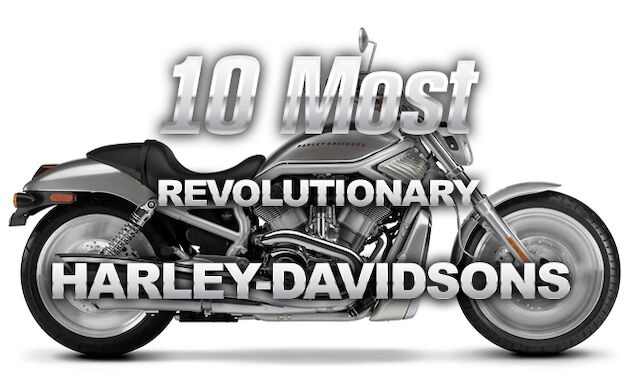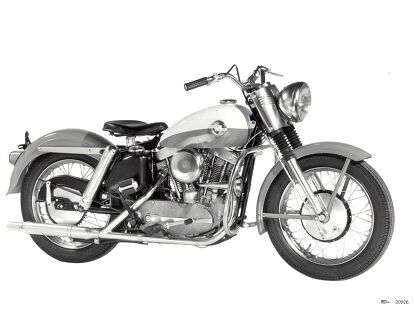Top 10 Most Revolutionary Harley-Davidsons!
You don't get to be 118 years old without knowing when to innovate a little
You have to be careful what you say in meetings. We were yukking it up over unlikely Top 10 ideas the other day, when I threw out “Most Revolutionary Harleys.” A few weeks later, here we are. The joke’s on me. After a little investigation and contemplation, it turns out a bunch of Harleys were pretty revolutionary, in the context of Harley-Davidson at least. And when you start bagging on Harley for being a bit hidebound, you also need to step back and try to remember the last time Honda ventured outside its box? Or Suzuki? The bigger and older the company, the more things stay the same – mostly because that’s how the customer likes it. But not so much these ten things:
1919 Model W Sport Twin
Stop me if you’ve heard this one before: The Model W was a new middleweight entry-level model designed to grow the motorcycle market by appealing to new riders! Its 584 cc side-valve flat-twin (like a BMW boxer but running fore-and-aft) was ahead of the game at the time: H-D’s first flathead was also its first bike with the (3-speed) gearbox inside the engine cases, which served as a stressed frame member. But all that tech meant the small Hog cost almost as much as a Big Twin. It was big in Europe! But when Indian introduced its first Scout in 1920 – faster, cheaper and cooler than the W – it was removed from the menu after 1923.
1936 EL Knucklehead
The Great Depression saw Harley sales plunge from 24,000 units in 1929 to 3700 by 1933, and nobody knew how bad it might still get. While there was nothing to do but worry, the MoCo developed its first overhead-valve V-twin, a 45-degree 60-inch (988cc) all-new engine with valve covers reminiscent of clenched fists. Valves were operated via push rods driven by a single, multi-lobed camshaft, and a recirculating lubrication system replaced primitive total-loss oiling. The new engine was rated at 40 horsepower. The EL framed the look for the next 85 years, right up until the present, with its chrome pushrod tubes, gas tank-mounted instruments, and that straight hardtail-line from front to rear axle. The EL pulled Harley out of the Depression, through WW2, and by 1947 the company was moving 20,000 units per year again – 11,000 of which were Knuckleheads.
( The Harley-Davidson Story: Tales from the Archives, $19, Aaron Frank)
1957 Sportster XL
H-D’s response to the British invasion of the early `50s, when Triumph, Norton, and BSA were drinking its milkshake through a big straw, was the 1952 Model K. The K was the sportiest bike Harley had ever built, and when it still couldn’t outperform the 650 British twins, the ante was upped: The 1957 Sportster XL and its new 883 cc Ironhead OHV V-twin was a match for anything English, and it got plenty of Americans to return to the home team. The Sportster was Harley’s biggest seller by 1970, introduced God knows how many youths to motorcycling, and soldiered on until ahh, sounds like this year could be its last; if so, 64 years was a helluva run.
1971 FX Super Glide
Before the Super Glide, there were big Harleys (FL touring bikes) and small Harleys (XL Sportsters). The Super Glide changed all that, mating small Harley parts (mostly the whole front fork assembly) to the big Electra Glide engine and chassis, to create what is generally agreed upon as being the first factory custom motorcycle. This Glide led directly to every Harley since that’s not a touring bike or a Sportster. Here’s Cycle magazine’s conclusion from 1970 (read the whole thing here):
Visually, like it or not, the Super Glide is a dazzler, and H-D’s commitment is a dazzling commitment. With the exception of the sickening failure of the brakes(!), the Super Glide is everything mechanically that it promises visually to be; and it will succeed in this country like no machine H-D has ever made or dreamed of making.
1978 MX250
H-D had a relationship with the Italian bike maker Aermacchi since about 1960, and at some point in the mid`70s, it couldn’t help noticing how many MX motorcycles the kids were snapping up. In 1978, the MX250 was sprung. Motocrossactionmag.com tells us around 900 were built before the plug was pulled, many of which went unsold if they were even lucky enough to have made the journey from the Italian factory. Serial #1, pictured here, made the crossing. Iconic auctioned it off at $18,500!
It is unlikely that the regular clientele at Harley dealerships was interested in dirt bikes or that motocross racers would have wandered into a Harley-Davidson dealership looking for a dirt bike. After the 1978 debacle, Harley sold Aermacchi to the Castiglioni brothers who changed the name to Cagiva… Motocross Action did not test the 1978 Harley MX250 because Harley-Davidson was afraid of critical tests (although they did advertise the bike in MXA). The retail price was $1695. – MXA
1981 Project Nova
This one was so revolutionary it didn’t get built. Porsche built the 135-horsepower liquid-cooled DOHC V-four engine, Milwaukee did the rest. A couple dozen running engines were built and put into a dozen prototype motorcycles, which put in many dyno hours, wind-tunnel testing, and 100,000 road miles. But making the jump to putting the Nova into production, the lore goes, was too great an economic leap for H-D to be able to make at the end of the flat-broke AMF era: The hard decision was made to stay on the V-twin path and develop new Evolution V-twins instead. If there had been funding, the Nova would’ve beaten Honda’s first V45 Sabre to market by one year.
1984 FXST Softail
If the Nova was Captain Tom Hanks in Saving Private Ryan, the new FXST Softail was Private Ryan – trying hard to earn its existence under a heavy burden of guilt. The very first Softail, with twin shocks hidden under the transmission to give a hardtail look without the hardtail ride, was also one of the first Harleys with the new, all-aluminum Evolution V-twin for which command had sacrificed the entire Nova squad.
The Softail was an instant hit, and pulled the Motor Company’s wagon out of the ditch once again. From 1984 forward, Harley’s been stamping out Softails in iterations too numerous to remember, and continues to do so today (even though the Softail frame was completely revised for 2018). The FXST didn’t just revolutionize an industry, says the great Terry Roorda, it created one.
2002 VRSC V-Rod
Of the first revolutionary Harley built in the MO era, we said “it’s a Harley for people who hate Harleys.” Calling again upon the Porsche connection from the Nova era, the VRSC became the first street-going H-D with a modern, DOHC liquid-cooled engine. Matter of fact, the 1131cc V-twin was called the Revolution engine, and was situated in an artistically hydroformed steel perimeter frame. Inspired by Harley’s VR1000 roadracer and by the H-D dragrace contingent, this power cruiser was also pretty good at going around corners. More to the point, for a company whose motorcycles are largely style-driven, the V Rod was a radical departure. The V Rod was liked, but not well-liked. Several variants appeared, but after the 2018 model year, the V-Rod was gone.
2019 LiveWire
The official word is that Harley wants to lead the world in electric motorcycles, which is not something we would’ve expected. Our man Duke first sampled a LiveWire in June of 2014, but bikes weren’t sold to the public until 2019, which is a thing that makes you immediately say hmmmmmm… I’ve yet to spot one of the $28,000 electric wonderbikes in the SoCal wild, but then all electric motorcycles are few and far between.
New H-D CEO Jochen Zeitz is on record as being fully behind the LiveWire and Harley’s electric future. Last October, the Milwaukee Business Journal quoted Zeitz: “It’s still an emerging category so sales volumes are relative. But from what I can see through all this we actually believe that LiveWire is the best selling on-highway or dual-electric cycle in the U.S. — actually selling more than double the next-highest electric motorcycle.”
2021 Pan America
Once again between a rock and a financial hard place, H-D is swinging for the fences with an all-new model in a new-to-it market teeming with very experienced sharks in a sea of mixed metaphors. But on paper, the Pan America 1250 (and Pan America Special) look like they know exactly what they’re diving into, and they seem to be packing all the gear they need to succeed: 150 horsepower from an all-new nearly maintenance-free engine with variable valve timing, the latest in IMU-controlled electronics (and even electronic suspension on the Special), and the long-range niceties sophisticated riders expect. All of it wrapped up in a distinctive, not-too heavy package wearing what so many riders crave – that famous bar and shield logo.
Feel free to bet against the Pan America. The fun part of little historical journeys like this one is remembering how many times in the last century people have lost that bet. It’ll be fun to watch, as always.
Become a Motorcycle.com insider. Get the latest motorcycle news first by subscribing to our newsletter here.
More by John Burns



















































Comments
Join the conversation
I'll just go with the 1936 EL Knucklehead thank you very much!
My V-Rods have far and away been my favorite motorcycles out of all that I've driven and owned.